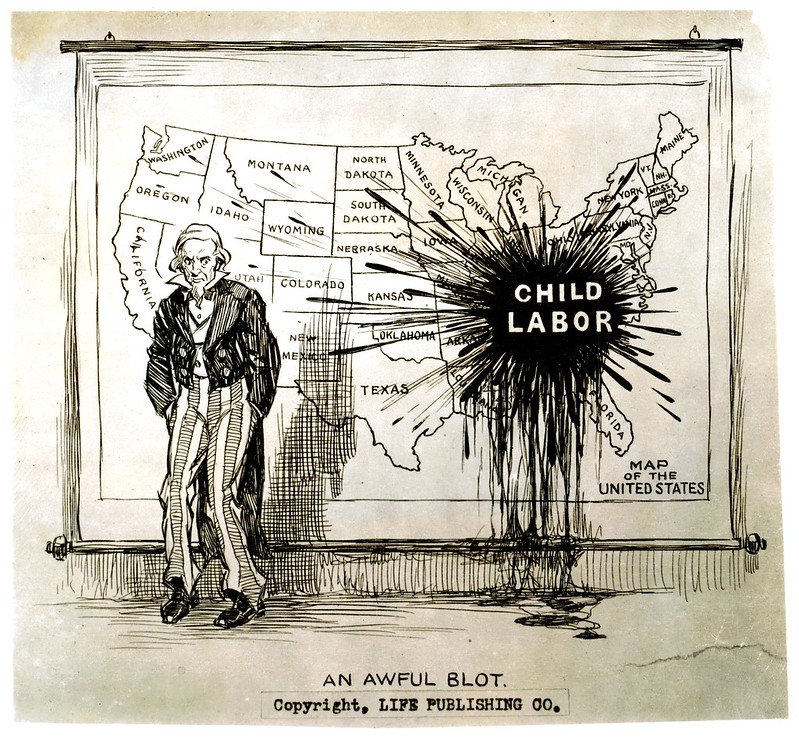Child Labor Is Not A Relic Of The Past
An infographic on child labor from the early 20th century from National Child Labor Committee (NCLC)
J.D. Thomas via Flickr
If you’ve taken a history class before, you’ve probably seen black-and-white images of small children in factories. Some of the most famous photographs come from Lewis Hine, who documented labor conditions in the United States during the Industrial Revolution — including the photo of a young boy working in a Minnesota coal mine. This is one of the quintessential photographs of the era, demonstrating the aberrant conditions faced by children at this time.
Unfortunately, child labor is not something that the U.S. did away with entirely, even following labor protections put forward to prevent the exploitation of children. Recent investigations have shown the extent to which child labor exists now, with legislation recently stripping protections for minors in the workplace. It is essential to recognize these problems in our labor force and support ways to minimize exploitation in the United States.
Historically, the Fair Labor Standards Act of 1938 (FLSA) placed several reforms on labor across the state, setting minimum wages, maximum hours of work for people working across state lines and limits on child labor. This act prohibits the employment of kids under 16 years of age working in mines and manufacturing. This federal law is still in effect to this day, with the U.S. Department of Labor providing resources for the public.
However, protection for children working in agriculture has always been an issue in the U.S. Under the law, the Department of Labor states that there are parental exemptions for minors working on farms owned by the family, and that these protections vary from state to state. This means that children under the age of 16 can legally work under certain circumstances despite FLSA restrictions, according to the National Agricultural Law Center. Provisions in the FLSA allow some states to change the age at which children can legally work and rules governing education-work time balance.
The issue today lies heavily in how these rules are implemented, and what loopholes are used to evade child labor violations. A recent report by NPR investigated how children cannot buy cigarettes but are allowed to work in tobacco fields, with how the FLSA is structured for children in agriculture. One interviewee, José Velásquez Castellano, described his experience working in North Carolina tobacco fields in sweltering heat with long hours, inconsistent pay and negative health consequences from working with tobacco — a substance he couldn’t legally purchase.
Castellano’s situation is hardly unique. A 2015 investigation by the Human Rights Watch into children working in tobacco fields in the U.S. speaks to the gravity of the situation, noting the health risks for children working in poor conditions in tobacco fields.
Despite investigations pointing to these atrocities, child labor in the U.S., and the halting of key protections, has continued. Earlier this month in Iowa, a bill was passed in the State Senate that would allow minors to work longer hours and work in previously prohibited positions, like serving alcohol and working on light assembly lines, according to Vice. An article by the Associated Press points out that proponents of the bill — largely Republicans — believe this will allow children to gain valuable work experience; but, Democrats and labor unions worry that this is an attempt to further roll back labor protections for children and could result in injury for children working these dangerous jobs.
The bottom line is that it’s disturbing to see state legislatures roll these labor protections for minors, but why does the U.S. allow this to happen?
A report by the Washington Post revealed how one Florida-based lobbying group, Foundation for Government Accountability (FGA), has been a key player in how recent legislation is able to pass in the states loosening protections for minors. The lobbying branch of this organization, the Opportunity Solutions Project, is popular among Republicans, with a win for FGA coming with an Arkansas law that removes the need for children under 16 to provide work permits and age verification.
The Post report notes that FGA has worked in other states to help lawmakers shape policy around labor, and that the federal government is working to tighten up existing protections for minors. The reach of this group spans several states — a critical factor in why these types of laws are able to garner support and be passed.
For many minors, working is important to support themselves and their families. It is why certain jobs are open to minors and many are working actively. However, minors should be guaranteed protection under the law across the United States to work safely. This means making sure adequate labor protections are in place, supporting legislation that combats child labor and not providing support to legislation that counters this effort.
History tends to repeat itself and it seems that this is the case with child labor. The black-and-white photos of mistreated child laborers aren’t as far behind us as we think.
